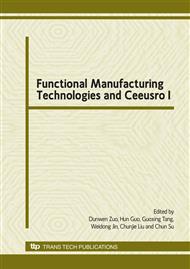p.303
p.308
p.312
p.316
p.320
p.325
p.330
p.334
p.339
Study on the Kinematics of the Lips of the Twist Drill on the Axial Vibration Part 2: Theoretical Chip Length and Dynamic Angles of the Drill
Abstract:
In vibratory drilling, the chip lengths and working angles alter respectively, and play important part in the process for the quality, efficiency, and chip breakage. The length of the edge movement in real drilling is just the theoretical length of the chip as the distance between the adjacent entering point and detaching point. It is revealed that from the condition of hm=0, the chip breaks automatically in the disjunction vibratory drilling pattern. Change of the dynamic angles was researched and based on the finding that the dynamic angle change undulates cyclically versus vibratory phase angle as well as the axial velocity in magnitude and direction of the drill, generated from the input of vibratory signals, the best performance of the drill in work may be pursued with the optimal working angle and clearance angle obtained by selecting the input vibratory parameters and selecting other drilling parameters in proper order.
Info:
Periodical:
Pages:
320-324
Citation:
Online since:
January 2010
Authors:
Keywords:
Price:
Сopyright:
© 2010 Trans Tech Publications Ltd. All Rights Reserved
Share:
Citation:


